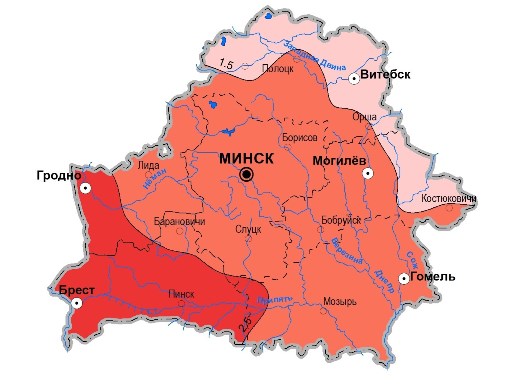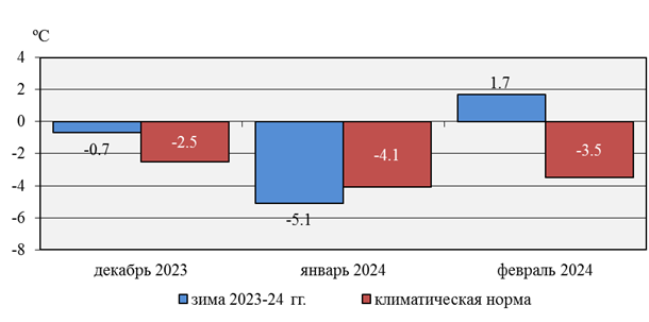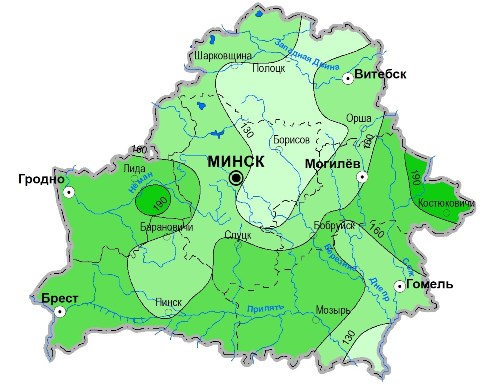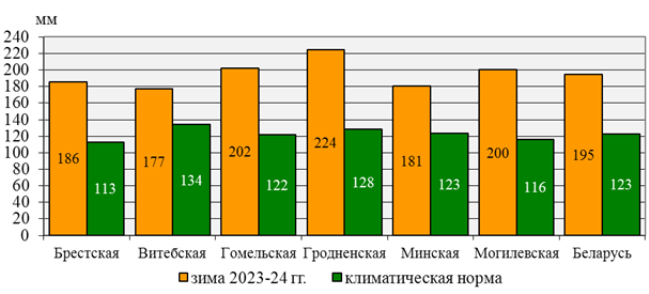05.03.2024
Climate characteristics of winter 2023/2024
The average air temperature of the winter season of 2023/2024 was -1.4°C, which is 2.0°C above the climatic norm. The past winter season took the 6th place in the ranked series of observations from the warmest to the coldest season, starting in 1881.

Deviation of the average air temperature of the winter season
from the climatic norm (-3.4°C) in the Republic of Belarus
A positive anomaly of seasonal air temperature was observed throughout the country, which was mainly in the range of 1.5-2.5°C.

Deviation (°C) of the average air temperature of the winter season
from the climatic norm on the territory of Belarus
The greatest positive deviations of air temperature from the climatic norm were noted on the territory of the Brest region (on average in the region +2.7°C), the smallest – in the territory of the Vitebsk region (on average in the region +1.4°C).
The temperature regime of the winter season was heterogeneous. December and February were warm with a positive anomaly of 1.8 and 5.2°C, respectively. The average temperature in January was 1.0°C below normal.

The average air temperature and climatic norm for the months
of the winter season 2023/2024 in the Republic of Belarus
The average air temperature in Belarus for the first winter month was -0.7°C, which is 1.8°C above the climatic norm. December 2023 ranked the 15th place in a ranked series of observations from the warmest to the coldest since 1945. The maximum value (+9.5°C) air temperature reached in the afternoon of December 25 at the Pinsk station. The minimum air temperature was recorded at the Lyntupy station on December 6 and amounted to -16.6°C.
The transition of the average daily air temperature through 0°C downward (the beginning of the climatic winter) in the north, east, central and south-east of the country took place from the middle of the second decade of November, and in the rest of the territory – at the end of the third decade of November. In the extreme south-west of the country, the transition did not take place.
The average air temperature in Belarus in January was -5.1°C, which is 1.0°C below the climatic norm. The maximum air temperature for the month was recorded at Brest and Vysokoye stations on January 30 and amounted to +6.6°C. The minimum temperature value (-28.7°C) was noted at the Yezerishche station on January 8.
The average air temperature in Belarus in February was +1.7°C, which is 5.2°C above the climatic norm. February of this year took the 2nd place in the ranked series of observations from the warmest to the coldest, since 1945. The maximum air temperature for the month was recorded at Brest station on February 27 and amounted to +16.1°C. The minimum air temperature was recorded at Kostyukovichi station on February 9 and amounted to -15.2°C.
During the winter, an average of 195 mm of precipitation fell across the country, which is 159% of the climatic norm for the season. The winter season 2023/2024 took the first place in a ranked series of observations from the wettest to the driest season since 1945. Excessive moisture was noted everywhere, 130-190% of the seasonal norm fell in most of the country.

Deviation (%) of the amount of precipitation for the winter season
from the climatic norm on the territory of Belarus
In the regional context, the largest amount of precipitation was observed in the Grodno region (224 mm or 175% of the norm). The lowest is in the Vitebsk region – 177 mm or 132% of the precipitation norm.

The amount of precipitation for the winter of 2023/2024 and the climatic norm
for the regions and territory of Belarus
The winter season 2023/2024 was characterized by excessive moisture throughout all three months.

Precipitation and climatic norm
by months of winter 2023/2024
In winter, precipitation fell mainly in the form of snow, sleet and rain. The snow cover, which was established at the end of November, reached its maximum values by the end of the first to the middle of the second decade of December, and was mainly in the range from 10 to 55 cm. By the end of the month, as a result of the predominance of positive air temperatures and frequent precipitation of liquid precipitation, the snow cover collapsed in most of the country, with the exception of the far east, where its height on the last day of the month ranged from 0.1 cm (Kostyukovichi) to 14 cm (Mstislavl). In January, the maximum height of the snow cover was observed in the second decade of the month and ranged from 11 cm to 47 cm. The thawing weather established in the third decade contributed to the melting of snow and on the last day of the month the height of the snow cover ranged from less than 0.5 cm (Grodno, Pruzhany) to 32 cm (Novogrudok), there was no snow cover in the extreme south-west of the country. During February, snow cover was stable throughout most of the country, with the exception of the western and southern regions, where snow cover was repeatedly formed and destroyed. By the end of the month, as a result of the predominance of daytime positive air temperatures and frequent precipitation of liquid precipitation, snow cover was absent almost everywhere, with the exception of individual observation points, where the height of the snow cover ranged from less than 0.5 cm (Naroch) to 5 cm (Mstislavl).
On some days, fogs, snowstorms, and icy phenomena were observed. On the afternoon of February 5, hail with a diameter of 11 mm was observed at the Brest station. A thunderstorm was registered at Mstislavl station on February 4 and 7. In some places, there was an increase in wind speed with gusts up to 15 m/s or more. The maximum wind speed was recorded on December 25 at the Drogichin station and on February 5 at the Slutsk station and amounted to 22 m/s.
When using the information reference to Belhydromet is obligatory








 Official heraldic symbols of the Republic of belarus
Official heraldic symbols of the Republic of belarus
 Internet portal of the President of the Republic of Belarus
Internet portal of the President of the Republic of Belarus
 National legal Internet portal of the Republic of Belarus
National legal Internet portal of the Republic of Belarus
 Ministry of natural resources and environmental protection of the Republic of Belarus
Ministry of natural resources and environmental protection of the Republic of Belarus